Indefinite Travel Restrictions Loom Over New Variant Fears
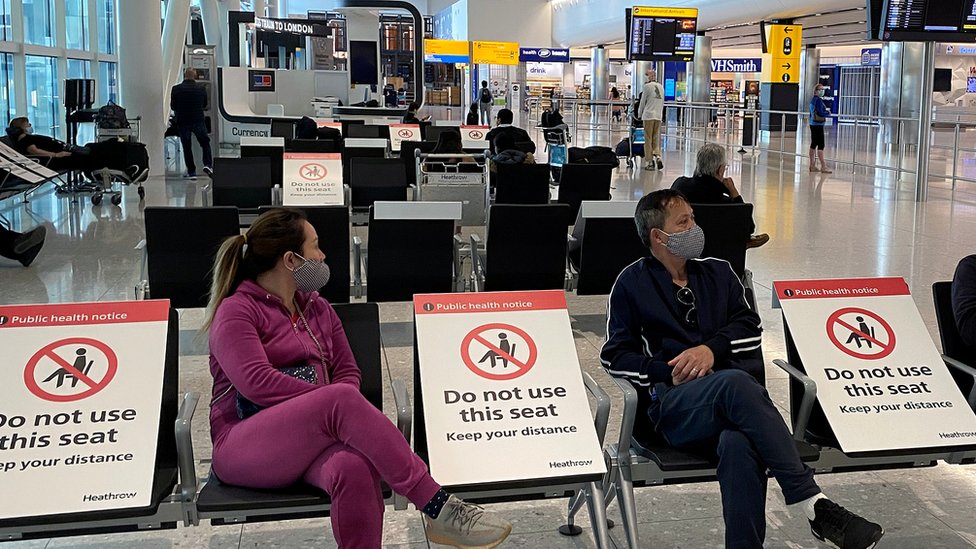
With the ever-present prospect of the emergence of new virus variants that can escape or weaken vaccine protection, it appears to be dawning on Government figures that a vaccine-dependent recovery will have to be one with closely guarded borders. This means that even when restrictions are lifted domestically, strict border controls are likely to remain, and it is not clear when it will be deemed safe to remove them. James Forsyth in the Spectator has his ear to the ground in Westminster.
The view is that testing and tighter procedures at the border will be needed to protect the UK from the danger of any vaccine-resistant strain. Priti Patel’s admission this week that the Government should have shut the borders last March is revealing of the current conversations inside Government on what to do, and the way in which they are going.
One thoughtful figure in Government tells me that “the advantage the vaccine has given us is so huge that we have to protect that”. The Government is particularly interested in how Australia has used tough border measures to keep Covid out; the country has had under a thousand deaths from the virus during the pandemic. There is a feeling that Australia is a “parallel democracy” and so the restrictions used there could be replicable here.
This Australian-style system – whereby entry is refused except to residents and those with an exemption, and quarantine must take place in a state-approved facility – would be devastating for business travel and tourism. But there is a growing sense in Westminster that this might be a price worth paying to protect the domestic economy from potential new strains of Covid until other countries have caught up with their vaccination programmes. Though even advocates of the strictest measures accept that hauliers would have to be exempt from quarantine and allowed in (if they had a negative test) to keep trade flowing. Others are sceptical, suggesting the Australian approach is possible only because of its geographical isolation.
Fraser Nelson takes a look at this issue in his Telegraph column this week, and urges a rethink.
Before the pandemic, Brits flew abroad more than any other people in the world, Americans included. Travel is about community, not just investment and trade. I have a divorced friend who now lives in Malmo, but travels back every other week to be with her son in London. What becomes of such families?
You can see the arguments for a Fortress Britain strategy. That, if we’re one of the first countries in the world to reopen, we should exploit that advantage – and not risk it all by letting a new variant fly in via Heathrow. But there are plenty of arguments against. Surely, if we’re vaccinated, we have less reason to fear the virus, so we can open up? Also, there have been some 20,000 mutations of Covid – none of which, so far, threaten to dodge the vaccine. Might we be overstating the risk?
Worth reading in full.
Stop Press: The Prime Minister of New Zealand, standard-bearer of the Zero Covid crowd, has signalled her intention to live with Covid through rolling vaccine programmes “as we do seasonally, with the flu”. Stuff has more.
Prime Minister Jacinda Ardern has used her first public remarks for the year to declare 2021 “the year of the vaccine” and stated the Government’s goal is getting Covid to the point where it will be managed like the common seasonal flu…
“Our goal has to be though, to get the management of COVID-19 to a similar place as we do seasonally, with the flu. It won’t be a disease that we will see simply disappear after one round of vaccine across our population,” Ardern said.
Are Infections Really Rising?

Many news outlets yesterday reported claims from the latest React study at Imperial College London that COVID-19 infections may be rising, despite the Government dashboard and ZOE Covid Symptom Study App showing new infections falling since the start of the year.
Ross Clark in the Spectator tries to get to the bottom of this discrepancy.
The React study… is based on testing a randomised sample of the population. Between January 6th and January 15th, it tested 142,909 people across the country, of which 1,962 were positive. That figure was then used to estimate that 1.58% of the population had the virus between those dates.
But React has a major weakness in that it is not a continuous survey; rather it is carried out in rounds, the last of which was between November 25th and December 3rd. It can tell us that prevalence grew between that period (when 0.91% of the population was estimated to be infected) but there is no data for the intervening period.
How, then, does it come to the conclusion that cases may have risen since the beginning of the third lockdown, which began on January 6th? Interestingly, the Office for National Statistics’ summary of the React study does not make this claim. It merely states there is “no strong evidence for either growth or decay in prevalence across the period January 6th and January 15th”. It is only when you go to the paper itself, published by Imperial, that it makes the assertion that infection levels “may have started to rise” at the end of the period – a claim it says it makes on the strength of analyses using “P-splines” – an analytical technique which seeks to smooth out lines generated from limited amounts of data.
A flimsy basis for such an alarming claim then. But it does make for an eye-catching headline…
Long Lockdown Starts Looking Even Longer
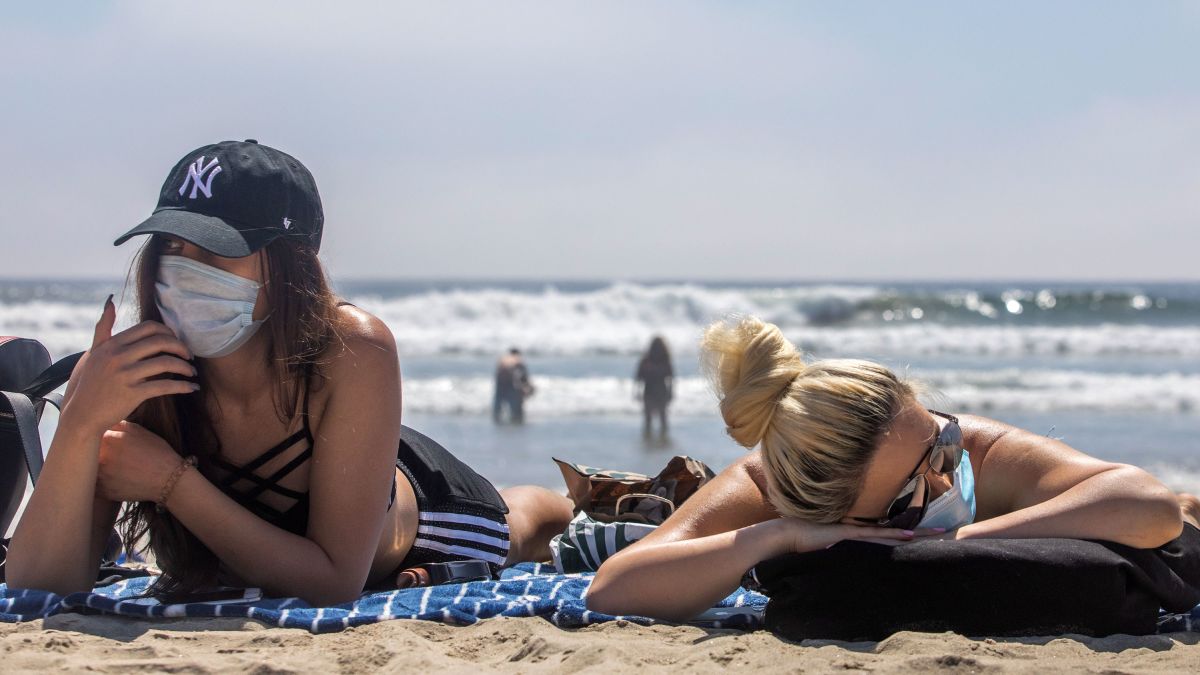
It was reported yesterday that Prime Minister Boris Johnson will not rule out continuing restrictions into the summer. MailOnline has the details, in a report snappily titled: “PM refuses to rule out lockdown lasting to SUMMER amid claims he is willing to keep curbs longer to make sure it’s the last national squeeze – despite UK cases slumping for 12th day in a row and rise in deaths easing.”
Boris Johnson today refused to rule out the brutal lockdown lasting until the summer amid claims he is willing to keep curbs longer to ensure it is the last national squeeze.
The PM insisted it is “too early to say” whether the restrictions will stay in place for months longer – despite cases falling by more than a fifth on last week and hopes rising that the most vulnerable groups will be vaccinated by mid-February, with a record 366,919 jabs administered in 24 hours.
Mr Johnson also delivered a stark message that the new coronavirus strain is “much more contagious”, repeating his plea for people to stay at home and obey the rules.
The intervention came as scientists delivered a grim warning that even mass vaccinations will not be enough to stop the disease spreading, suggesting that measures will need to remain longer.
There are claims from the PM’s circle that he is ready to risk the wrath of Tory MPs – who are clamouring for confirmation of an easing starting March 8th – by persisting with the curbs.
The UK recorded another 37,892 infections today, but that was down more than a fifth on last Thursday.
There were another 1,290 deaths but that was up just 3.4 per cent on the same day last week, suggesting that the rate might be slowing.
Boris cited the questionable React study data in justifying his caution.
On a visit to see flooding in Greater Manchester today, Mr Johnson was asked whether lockdown could stay until the summer.
“I think it’s too early to say when we’ll be able to lift some of the restrictions,” he said.
“We’ll look then (February 15th) at how we’re doing but I think what we’re seeing in the ONS data, in the React survey, we’re seeing the contagiousness of the new variant that we saw arrive just before Christmas – there’s no doubt it does spread very fast indeed. It’s not more deadly but it is much more contagious and the numbers are very great.”
He said it is “absolutely crucial” to obey the current restrictions “in what is unquestionably going to be a tough few weeks ahead”.
The Prime Minister’s official spokesman said: “We will continue to keep all of the scientific evidence and data under review. It remains our position that we want to ease restrictions as soon as it is safe to do so, but in order for us to do that we need to see the transmission rates of the virus come down and we need to see the pressure on the NHS reduce. It is our intention and our hope that this will be the last national lockdown.”
Worth reading in full.
What Happened to Plan A?

In these days when being known as a sceptic can lead to notoriety it can be hard to remember that the approach favoured by the sceptics is nothing other than the pandemic plan the Government had prepared on the basis of WHO advice. A Lockdown Sceptics reader has revisited this plan, which is still available here and was reaffirmed as recently as February 27th last year, and copied out some excerpts to show how far current policy differs from it.
The envisaged death toll from the hypothetical pandemic (assumed to be flu but allowing for the possibility that it might be something similar to SARS) is given as 210,000-315,000. This was assumed to occur in as little as 15 weeks with perhaps half the deaths, up to 158,000, in just three weeks. These death tolls are significantly higher than the current UK Covid death toll (95,000 according to the Government dashboard), even allowing for the inflated PCR-based metric and the fact that we are now adding on the usual excess winter deaths as well.
Our reader observes:
Seen from my rather soggy molehill in God’s own county (Essex) we tore up the plans and threw them out the window with very little new knowledge, and absolutely no publicly made justification, in March, on the back of one single model produced by a nutter with form from previous incidences.
Yet even Neil Ferguson’s model of doom was only projecting 510,000 deaths, not a far cry from the 315,000 envisaged in the plan, making the Government’s mid-March volte face even harder to fathom. The reality is, the incoming pandemic was textbook, but the textbook was discarded.
From the plan (emphasis added):
2.12 This means that it almost certainly will not be possible to contain or eradicate a new virus in its country of origin or on arrival in the UK. The expectation must be that the virus will inevitably spread and that any local measures taken to disrupt or reduce the spread are likely to have very limited or partial success at a national level and cannot be relied on as a way to ‘buy time’.
2.20 For deaths, the analysis of previous influenza pandemics suggests that we should plan for a situation in which up to 2.5% of those with symptoms would die as a result of influenza, assuming no effective treatment was available.
A pandemic is most likely to be caused by a new subtype of the Influenza A virus but the plans could be adapted and deployed for scenarios such as an outbreak of another infectious disease, e.g. Severe Acute Respiratory Syndrome (SARS) in health care settings, with an altogether different pattern of infectivity.
It will not be possible to stop the spread of, or to eradicate, the pandemic influenza virus, either in the country of origin or in the UK, as it will spread too rapidly and too widely.
Taking account of this, and the practicality of different levels of response, when planning for excess deaths, local planners should prepare to extend capacity on a precautionary but reasonably practicable basis, and aim to cope with a population mortality rate of up to 210,000 – 315,000 additional deaths, possibly over as little as a 15 week period and perhaps half of these over three weeks at the height of the outbreak.
4.11 To protect others and reduce the spread of infection, anyone ill with pandemic influenza should:
– Stay at home.
– Minimise close contacts.
– Adopt thorough respiratory and hand hygiene practices, i.e. covering the nose and mouth with a tissue when coughing and sneezing, disposing immediately of that tissue after use, and washing hands frequently with soap and warm water, or alcohol gel if water is not readily available.4.15 Although there is a perception that the wearing of facemasks by the public in the community and household setting may be beneficial, there is in fact very little evidence of widespread benefit from their use in this setting. Facemasks must be worn correctly, changed frequently, removed properly, disposed of safely and used in combination with good respiratory, hand, and home hygiene behaviour in order for them to achieve the intended benefit. Research also shows that compliance with these recommended behaviours when wearing facemasks for prolonged periods reduces over time.
4.18 The Foreign and Commonwealth Office will issue advice regarding travel to affected countries. There are no plans to attempt to close borders in the event of an influenza pandemic. The UK generally has a high level of international connectivity, and so is likely to be one of the earlier countries to receive infectious individuals. Modelling suggests that imposing a 90% restriction on all air travel to the UK at the point a pandemic emerges would only delay the peak of a pandemic wave by one to two weeks 10,11. Even a 99.9% travel restriction might delay a pandemic wave by only two months. During 2009 it became clear that the pandemic virus had already spread widely before international authorities were alerted, suggesting that in any case the point of pandemic emergence had been missed by several weeks. The economic, political and social consequences of border closures would also be very substantial, including risks to the secure supply of food, pharmaceuticals and other supplies.
Restrictions on public gatherings and public transport
4.21 There is very limited evidence that restrictions on mass gatherings will have any significant effect on influenza virus transmission. Large public gatherings or crowded events where people may be in close proximity are an important indicator of ‘normality’ and may help maintain public morale during a pandemic. The social and economic consequences of advising cancellation or postponement of large gatherings are likely to be considerable for event organisers, contributors and participants. There is also a lack of scientific evidence on the impact of internal travel restrictions on transmission and attempts to impose such restrictions would have wide-reaching implications for business and welfare.
4.22 For these reasons, the working presumption will be that Government will not impose any such restrictions. The emphasis will instead be on encouraging all those who have symptoms to follow the advice to stay at home and avoid spreading their illness. However, local organisers may decide to cancel or postpone events in a pandemic fearing economic loss through poor attendances, and the public themselves may decide not to mix in crowds, or use public transport if other options are available.
School closures
4.23 There is modelling data highlighting the potential benefit of school closures in certain circumstances, both in terms of protecting individual children from infection and in reducing overall transmission of the virus in the population. However, to be effective prolonged closures are required. This would involve schools over a wide area, but carries a risk that social mixing of children outside school would defeat the object of the closures.
Business as usual
7.4 During a pandemic, the Government will encourage those who are well to carry on with their normal daily lives for as long and as far as that is possible, whilst taking basic precautions to protect themselves from infection and lessen the risk of spreading influenza to others (see Chapter 4). The UK Government does not plan to close borders, stop mass gatherings or impose controls on public transport during any pandemic.
Was the November Lockdown Effective?
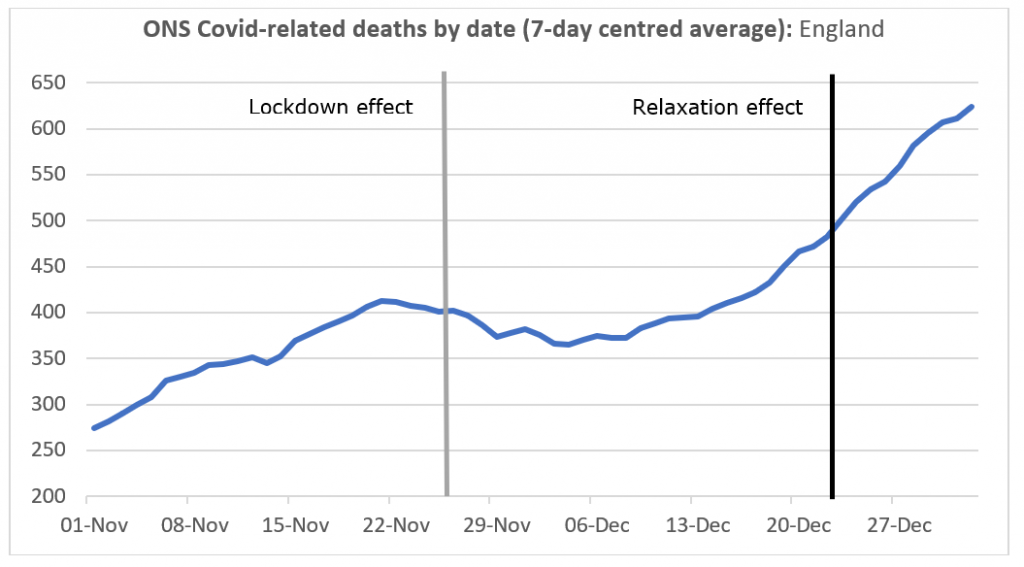
There follows a guest post by David Paton, Professor of Industrial Economics at Nottingham University Business School, who tweets as @CricketWyvern.
Recent data have confirmed beyond doubt that infections in most if not all regions of England were falling before the national lockdown was even announced on January 4th. Whether the falls can be attributed to the earlier imposition of strict Tier 4 restrictions is another matter though it is noteworthy that decreases in Yorkshire, which never went into Tier 4, started at a similar time to the South East which had been in Tier 4 from before Christmas.
Queries over whether the latest lockdown was necessary to reduce infections have resurrected debates about the effectiveness of the last national lockdown imposed on England on November 5th. For example, Christopher Snowdon of the IEA has argued recently that this is a clear example of effective lockdown. But does his claim stand up to scrutiny of the data?
Our best reference point is the ONS series of COVID-19 related deaths by date of occurrence. Based on information from death registrations, it gives us the best indicator of trends in infections.
Although there is some uncertainty over the average lag between infections and death, we should expect any effect of lockdown to be visible in the deaths series after about three weeks.
So if the November 5th lockdown had been effective, we might expect an effect on the deaths trend from around November 26th. Similarly, if the relaxation of lockdown measures on December 2nd led to an increase in infections, we might expect an effect on the deaths trend from about December 23rd.
Figure 1 shows the trend in deaths by date of occurrence in England over the relevant period using the centred seven-day average to smooth the series. The series ends on January 1st as delays in death registration may mean it is not complete after that point. The grey line indicates the likely point at which the lockdown will have an effect, the black line indicates when we might see an effect of its lifting.
Deaths increase during November but peak on the 21st, just 16 days after the lockdown, almost certainly too early for that to be causing the decrease. Just as striking is that, although deaths do decrease thereafter, they only do so until December 4th after which they increase again. Given the infection-death lag, not only is it hard to attribute the decrease in deaths to the lockdown, it is clear infections start to increase again right in the middle of the national lockdown.
What about the impact of releasing the lockdown on December 2nd? Even if deaths are already increasing (perhaps due to spread of the new variant), we might expect to see the rate of increase go up from about December 23rd. But no, relaxing the lockdown has little observable effect on the trend.
One problem is that the national data aggregates various different regional trends. Looking at the regional data also helps to isolate some testable lockdown predictions. Much of the North and Midlands were already under quite tight restrictions by November 5th. Those areas also largely returned to even tighter restrictions when the lockdown was lifted. As such, we should expect any impact of both the imposition and the lifting of the national lockdown to be stronger in London, the East, the South East and the South West. Note London and most of the South East went into Tier 3 and then Tier 4 later in December, too late to effect deaths up to January 1st.
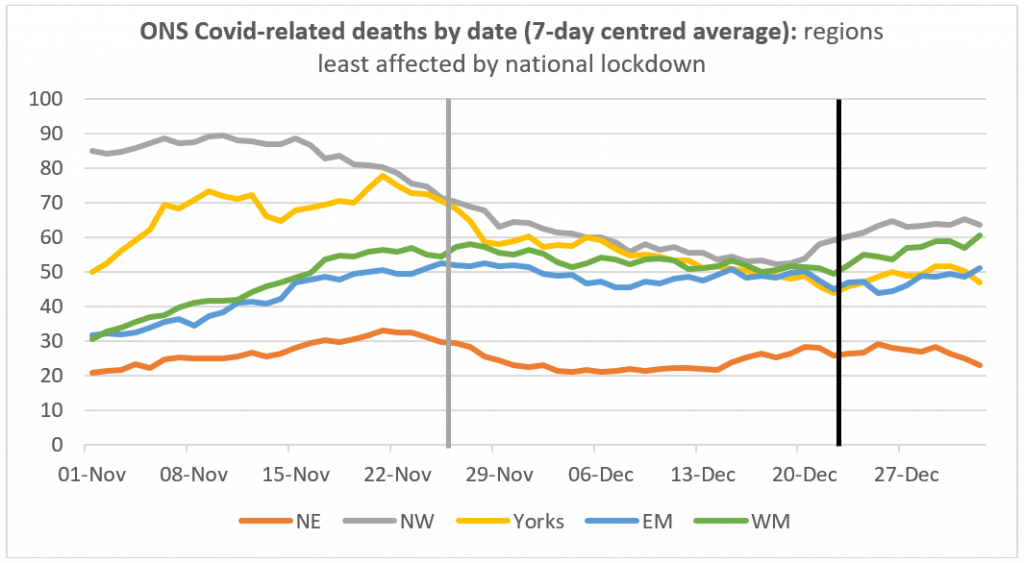
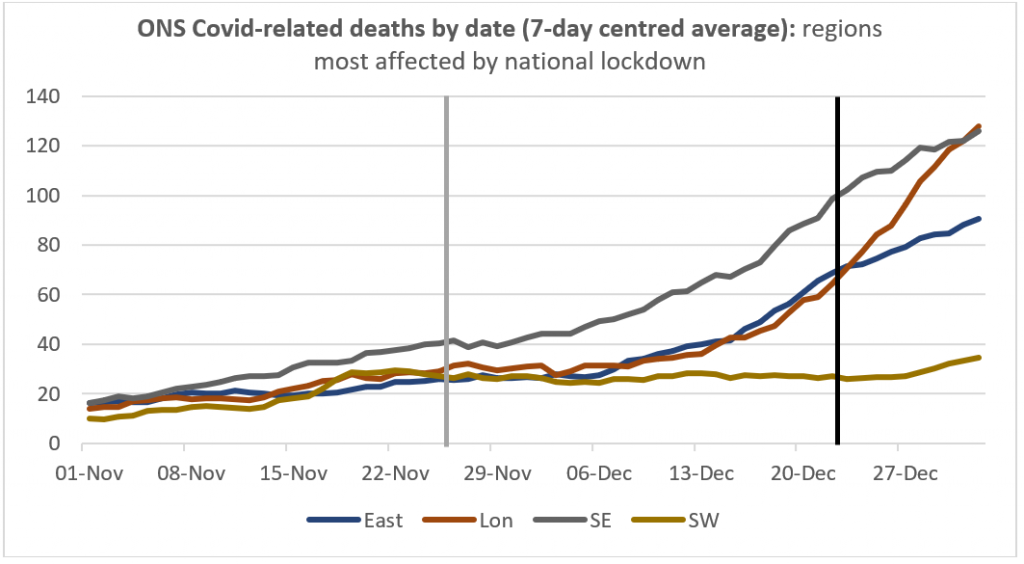
Figures 2 and 3 show the deaths trend for the regions least and most affected by the lockdown respectively. Deaths in the North West, North East and Yorkshire were decreasing well before the national lockdown was likely to have exerted any effect whilst deaths in the Midlands were stable before and after the likely impact. Similarly, it is hard to identify any significant effect on the deaths trend from lifting the national lockdown in December.
More striking is the lack of any obvious impact in those regions where we would expect the national lockdown to have had most effect. Possibly the slow increase we had been seeing in South East and London stabilised a little after lockdown, but only for a very short period of time. The South East, East and London all increase again about 10 days after the lockdown should have been having an effect and there is no obvious effect on the trends from the December lifting of the lockdown. The South West seems remarkably unaffected either by the lockdown or its lifting.

The deaths trends are consistent with hospital admissions (figure 4) which should be affected some 10-12 days after lockdown or relaxation. In fact admissions decreased from 12 Nov, too early for lockdown to be the cause and had started increasing again by November 30th before the lockdown had even been lifted.
Looking at the national and the regional pictures, it is hard to identify any beneficial impact of the November lockdown. Given the different factors going on: regional restrictions, development of the new variant and so on, it is impossible to rule out some marginal beneficial effects on the rate or timing of increase. But it is hard to see much in the data to suggest England’s November lockdown was effective in preventing any deaths or hospitalisations at all.
Given the huge costs involved with lockdown restrictions, the lack of any obvious benefit from both the November and (from the early data) the January lockdowns, raises important questions about our current strategy.
SAGE Should Not Even Exist
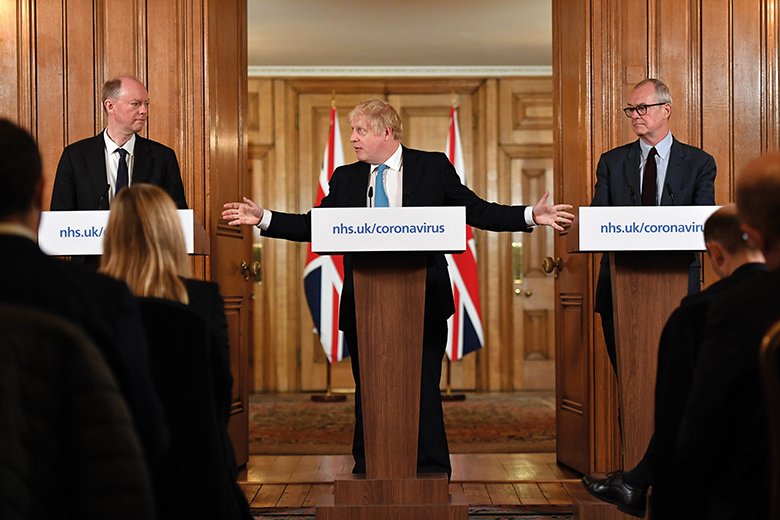
Today we’re publishing a new piece by Lockdown Sceptics contributor Sean Walsh. Bringing his distinctive philosophical edge to the analysis, Sean asks whether SAGE, as an organ of state power, is even capable of giving Government sound, objective advice.
It is always the mavericks who add the most to objective knowledge. In 1905 Einstein published four papers, each of which was a Nobel contender, and he wrote them in his spare time. With all due respect, Chris Whitty is no Einstein.
Things are, though, even worse than that. The Establishment ‘scientists’ have corrupted the worldview of the politicians they are supposed merely to advise. And the political class has passed that corruption of thought onto the people whose interests they are supposed to serve, not to define. In his excellent piece for Lockdown Sceptics, Ben Hawkins discusses Wittgenstein’s thoughts about the nature of certainty, and how it seems that some beliefs are foundational, that they serve as enabling conditions of thought in general. As Ben points out, for the High Priests of SAGE and their Government disciples the belief in lockdown has become cognitively indispensable. It’s not so much that they have rejected any alternatives to the current strategy. It’s that without a belief in the rightness of their approach, they are unable to think about the C19 problem at all.
Worth reading in full.
The Moral Panic Against Lockdown Sceptics

There follows a guest post by Rob Tyson.
Remember when that paediatrician was driven from her home by a gang of vigilantes who also daubed “paedo” on her door, in the mistaken belief they were dealing with a paedophile?
Maybe you remember the late 80s panic over Pitbull terriers and their feckless owners?
Readers of a certain age may remember the reported conflicts between “mods and rockers” of the 1960s.
All were classic “moral panics” and as I write we appear to be in another one, but this time, the “folk devils” are you, lockdown sceptics.
Observing the hysterically shrill response to anything outside of a narrow orthodoxy on our eminently questionable COVID-19 response by “moral entrepeneurs” such as Neil O’Brien MP, I suddenly remembered Stanley Cohen’s 1972 book Folk Devils & Moral Panics.
I don’t have the book anymore but Wikipedia does a good precis. The hysteria directed at lockdown scepticism since the turn of 2021 feels like a textbook example of a moral panic:
A moral panic occurs when “…[a] condition, episode, person or group of persons emerges to become defined as a threat to societal values and interests”.
Those who start the panic when they fear a threat to prevailing social or cultural values are known by researchers as ‘moral entrepreneurs’, while people who supposedly threaten social order have been described as “folk devils”.
According to Cohen, there are five key stages in the construction of a moral panic:
1. Someone, something or a group are defined as a threat to social norms or community interests
2. The threat is then depicted in a simple and recognizable symbol/form by the media
Yes, that’s you “covidiots”, “conspiracy theorists”, and “anti-vaxxers”. Not only that, but in recent days a “new variant” of derogatory labels has emerged: “denialists”.
An intriguing term, isn’t it? Being so flexible it is very useful to moral entrepreneurs, as Douglas Murray was quick to notice:
Cohen’s stages continue:
3. The portrayal of this symbol rouses public concern
4. There is a response from authorities and policy makers
5. The moral panic over the issue results in social changes within the community
Moral panics have several distinct features, say a couple of other researchers, Goode and Ben-Yehuda:
Concern – There must be the belief that the behaviour of the group or activity deemed deviant is likely to have a negative effect on society.
Hostility – Hostility toward the group in question increases, and they become “folk devils”. A clear division forms between “them” and “us”.
Consensus – Though concern does not have to be nationwide, there must be widespread acceptance that the group in question poses a very real threat to society. It is important at this stage that the “moral entrepreneurs” are vocal and the “folk devils” appear weak and disorganised.
Disproportionality – The action taken is disproportionate to the actual threat posed by the accused group.
Volatility – Moral panics are highly volatile and tend to disappear as quickly as they appeared because public interest wanes or news reports change to another narrative.
Concern – check.
Hostility – check.
Consensus – I would say we are seeing this hardening this week; certainly the moral entrepreneurs have been extremely vocal.
Then only today I saw this call for jail, not just for “Covid rule breakers” themselves, but for a “list” of “celebrities using their platform to encourage rule breaking”:
I’d consider that Disproportionality.
Let’s hope Volatility keeps up its side of the bargain too, and this moral panic doesn’t last too long.
A Dentist Writes…

Lockdown Sceptics reader and retired dentist Dr Mark Shaw has come up with a good analogy of the poor approach to risk in this pandemic.
I am very concerned about the way the risks associated with COVID-19 are being presented to the public.
Professional healthcare workers are generally held in high regard and the public trust them to look after their needs. It’s a privilege that the healthcare worker must never take for granted – and that trust must never be abused. If a professional health worker advises a patient to have a radiograph taken for diagnostic purposes, it is quite reasonable
for the patient to know whether it is absolutely necessary to have it and what the risks of having that exposure to radiation are (no matter how small). I would have to explain the pros and cons and put the risk in context.If the patient was having a total radiation exposure equivalent to a single chest x-ray, a good practitioner would explain some basics of natural background radiation exposure. Then the clinician could put things into context and describe this as being equivalent to roughly three days of additional background radiation.
If the practitioner was taking the patient’s trust for granted and intended to abuse that trust and try to alter the patient’s reasonable decision to opt for the x-ray, he or she could scare the patient by taking things out of context. Every time the patient came in to the clinic the clinician could say that diagnostic radiology causes 700 cancer cases a year – which might not be a lie.
Of course, if it is found that the health care professional is doing this and systems are in place that deal with patient safety and allow for whistle-blowing, then this practitioner can be reported and disciplined. If it persists the practitioner could rightly be struck off.
How can the Government, the medical establishment and media organisations that publicise the Covid death figures and Covid risks be allowed to do so in the way that they are doing? It is an absolute scandal.
The public are being misled by taking overall risks out of context. The classification of a Covid death as being a death within 28 days of a positive coronavirus test, the publication of these deaths on a daily basis, and the citing of positive tests as “cases” are only a few examples.
In a fair society all risks need to be kept in perspective and when that doesn’t happen those responsible need to be held accountable. In the medical and dental profession disciplinary action is taken in these situations to protect the public and so that lessons can be learned. It may be a little too late to halt the damaging (possibly catastrophic) effects of the publication of information that seems designed to scare the public into conforming to a particular agenda. I do not think it is too late for those responsible – the Government, some of the media and some healthcare professionals and their representatives to be held accountable and learn lessons.
How Well Has the BBC Covered this Crisis? Readers’ Views Requested

The Beeb is asking for the views of its audience, so do be sure to let them know.
We are really interested in understanding your views on the BBC and some of the other services you use. Here is a short survey that should take no longer than five minutes to complete and your answers will be completely confidential.
We will be looking at the results of the survey, alongside looking at how you and others use the BBC’s services when you are signed in to your account. For example, we might look at whether people who use the BBC a lot have a different view to those who don’t use it very often. This is to help us better understand how people feel about the BBC. The survey results and how you use the BBC will remain totally anonymous.
Find the survey here.
Round-up
- “Ministers consider £500 payment for positive Covid test” – The Telegraph reports that ministers are considering paying £500 to everyone who tests positive for Covid (costing £2 billion a month) amid concern that only one in six people with symptoms are getting tested because many can’t afford to self-isolate
- “Scientists challenge ‘flawed’ lateral flow tests report” – The PCR vs LFT battle heats up, with Prof Calum Semple, Prof Sir John Bell and PHE’s Dr Susan Hopkins among others coming out in defence of the beleaguered LFT, reports the BBC
- “Lockdown flouters will get £800 fine just for going to a party” – Enforcement ramps up, reports the Mail
- “Swiss propaganda on mortality” – The Swiss Doctor exposes the underhand efforts of Swiss national newspaper NZZ to discredit the factually accurate statement of chief physician Dr Vernazza that mortality among Swiss seniors in 2020 was roughly at the level of 2009-2015
- “Scruton, lockdown and the metaphysics of the face” – Sean Walsh in the Article brings the great thinker’s ideas to bear on present concerns
- “What makes us think they’ll release lockdown after vaccines?” – Entertaining and outrageous as ever, Rod Liddle in the Spectator has a serious point to make
- “The Madness of Crowds” – The latest episode of the Real Normal Podcast is out, taking a look at NHS failings, heroes and villains of Covid and looking ahead to the vaccine rollout and what potential there is for a free society
- “Covid debate won’t improve until ‘lockdowns’ themselves are questioned” – Michael Psaras in Bournbrook writes on the baffling lack of interest within Government and the media to question lockdown orthodoxy, “even though the policy of ‘lockdown’ is completely new and, surely by this very reason alone, is worth being sceptical about”
- “Lords Spooked by Parliament’s Halloween Unlock Timetable” – Guido notes the ominous news that Parliament’s events team have decided not to resume hosting events until October
- “Italy – China’s virus gateway to the West” – Edward Gifford in Conservative Woman wonders whether there’s a link between Italy’s eagerness to sign up to China’s Belt and Road Initiative and the country’s role in pioneering Chinese-style policies like lockdown
- “The showtrial of the sceptics” – Peter Hitchens joins Brendan O’Neill on the latest spiked podcast
- “US president Joe Biden signs 10 executive orders to curb spread of coronavirus” – New boss, new direction, though the president’s direct power to address public health issues in the US is limited
- “The COVID-19 suicides” – David Bullard writes in Politicsweb on the recent tragic deaths of three of his friends and acquaintances
- “Take Junction 3 off the road to Hell? That’s the choice ahead on lockdowns” – Jon Dobinson of Recovery writes in Think Scotland that for all the talk of vaccines, lockdown is “a cycle which will never end until we learn to live with this unpleasant virus”
- Ross Clark has hit back against Neil O’Brien for lashing out at lockdown sceptics
Theme Tunes Suggested by Readers
Ten today: “Anxious” by The Housemartins, “Living in a box” by Living in a box, “Please release me” by Engelbert Humperdinck, “19th Nervous breakdown” by Rolling Stones, “Going nowhere” by Neil Sedaka, “Confusion” by The Electric Light Orchestra, “Perilous Times” by Mystic Eyes, “Fool If You Think It’s Over” by Elkie Brooks, “Don’t Dream It’s Over” by Crowded House and “When Will I See You Again” by The Three Degrees.
Love in the Time of Covid

We have created some Lockdown Sceptics Forums, including a dating forum called “Love in a Covid Climate” that has attracted a bit of attention. We have a team of moderators in place to remove spam and deal with the trolls, but sometimes it takes a little while so please bear with us. You have to register to use the Forums as well as post comments below the line, but that should just be a one-time thing. Any problems, email the Lockdown Sceptics webmaster Ian Rons here.
Sharing Stories
Some of you have asked how to link to particular stories on Lockdown Sceptics so you can share it. To do that, click on the headline of a particular story and a link symbol will appear on the right-hand side of the headline. Click on the link and the URL of your page will switch to the URL of that particular story. You can then copy that URL and either email it to your friends or post it on social media. Please do share the stories.
Social Media Accounts
You can follow Lockdown Sceptics on our social media accounts which are updated throughout the day. To follow us on Facebook, click here; to follow us on Twitter, click here; to follow us on Instagram, click here; to follow us on Parler, click here; and to follow us on MeWe, click here.
Woke Gobbledegook

We’ve decided to create a permanent slot down here for woke gobbledegook. Today, it’s the worrying news that Boris Johnson has declared “there’s nothing wrong with being woke”. The Spectator has the details.
Labour’s shadow Foreign Secretary, Lisa Nandy, opened a Pandora’s box yesterday in an interview with the Guardian, in which she praised the new US President Joe Biden for being a “woke guy” and, according to the paper, appeared to suggest that those defending the Parliament Square statue of Churchill were comparable to white supremacists marching in America. Mr S imagines that isn’t quite the strategy the party had in mind to win back Red Wall towns lost in 2019.
Nonetheless, it appeared to be Boris Johnson who was struggling most with the idea of a ‘woke’ US President yesterday. In an interview with Sky News, the PM was asked if he thought Joe Biden was woke as well. At first, a visibly flustered Boris Johnson, clearly worried about poisoning US relations, sought to evade the question. But the PM then added the surprising admission that ‘there’s nothing wrong with being “woke”’.
It must clearly have been a different Prime Minister who was reportedly considering starting a “war on woke” last year…
Katy Balls added further analysis here.
Stop Press: Will Knowland, who was sacked from Eton for posting online a lecture questioning feminist orthodoxy, has told Freddie Sayers from UnHerd that he stands by his “patriarchy lecture”.
“Mask Exempt” Lanyards
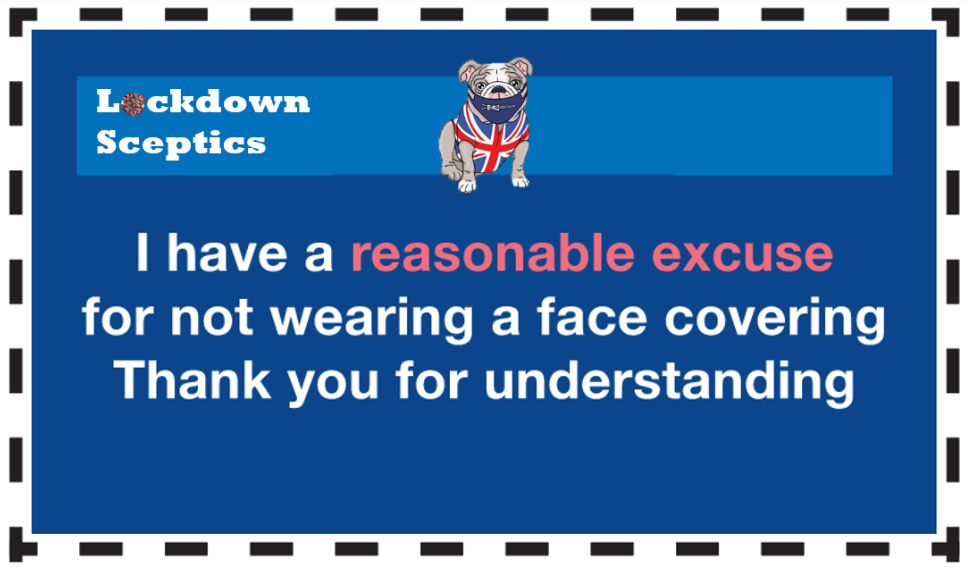
We’ve created a one-stop shop down here for people who want to obtain a “Mask Exempt” lanyard/card – because wearing a mask causes them “severe distress”, for instance. You can print out and laminate a fairly standard one for free here and the Government has instructions on how to download an official “Mask Exempt” notice to put on your phone here. And if you feel obliged to wear a mask but want to signal your disapproval of having to do so, you can get a “sexy world” mask with the Swedish flag on it here.
Don’t forget to sign the petition on the UK Government’s petitions website calling for an end to mandatory face masks in shops here.
A reader has started a website that contains some useful guidance about how you can claim legal exemption. Another reader has created an Android app which displays “I am exempt from wearing a face mask” on your phone. Only 99p.
If you’re a shop owner and you want to let your customers know you will not be insisting on face masks or asking them what their reasons for exemption are, you can download a friendly sign to stick in your window here.
And here’s an excellent piece about the ineffectiveness of masks by a Roger W. Koops, who has a doctorate in organic chemistry. See also the Swiss Doctor’s thorough review of the scientific evidence here and Prof Carl Heneghan and Dr Tom Jefferson’s Spectator article about the Danish mask study here.
The Great Barrington Declaration

The Great Barrington Declaration, a petition started by Professor Martin Kulldorff, Professor Sunetra Gupta and Professor Jay Bhattacharya calling for a strategy of “Focused Protection” (protect the elderly and the vulnerable and let everyone else get on with life), was launched in October and the lockdown zealots have been doing their best to discredit it ever since. If you googled it a week after launch, the top hits were three smear pieces from the Guardian, including: “Herd immunity letter signed by fake experts including ‘Dr Johnny Bananas’.” (Freddie Sayers at UnHerd warned us about this the day before it appeared.) On the bright side, Google UK has stopped shadow banning it, so the actual Declaration now tops the search results – and Toby’s Spectator piece about the attempt to suppress it is among the top hits – although discussion of it has been censored by Reddit. The reason the zealots hate it, of course, is that it gives the lie to their claim that “the science” only supports their strategy. These three scientists are every bit as eminent – more eminent – than the pro-lockdown fanatics so expect no let up in the attacks. (Wikipedia has also done a smear job.)
You can find it here. Please sign it. Now over three quarters of a million signatures.
Update: The authors of the GBD have expanded the FAQs to deal with some of the arguments and smears that have been made against their proposal. Worth reading in full.
Update 2: Many of the signatories of the Great Barrington Declaration are involved with new UK anti-lockdown campaign Recovery. Find out more and join here.
Update 3: You can watch Sunetra Gupta set out the case for “Focused Protection” here and Jay Bhattacharya make it here.
Update 4: The three GBD authors plus Prof Carl Heneghan of CEBM have launched a new website collateralglobal.org, “a global repository for research into the collateral effects of the COVID-19 lockdown measures”. Follow Collateral Global on Twitter here. Sign up to the newsletter here.
Judicial Reviews Against the Government

There are now so many legal cases being brought against the Government and its ministers we thought we’d include them all in one place down here.
The Simon Dolan case has now reached the end of the road. The current lead case is the Robin Tilbrook case which challenges whether the Lockdown Regulations are constitutional. You can read about that and contribute here.
Then there’s John’s Campaign which is focused specifically on care homes. Find out more about that here.
There’s the GoodLawProject and Runnymede Trust’s Judicial Review of the Government’s award of lucrative PPE contracts to various private companies. You can find out more about that here and contribute to the crowdfunder here.
And last but not least there was the Free Speech Union‘s challenge to Ofcom over its ‘coronavirus guidance’. A High Court judge refused permission for the FSU’s judicial review on December 9th and the FSU has decided not to appeal the decision because Ofcom has conceded most of the points it was making. Check here for details.
Samaritans

If you are struggling to cope, please call Samaritans for free on 116 123 (UK and ROI), email jo@samaritans.org or visit the Samaritans website to find details of your nearest branch. Samaritans is available round the clock, every single day of the year, providing a safe place for anyone struggling to cope, whoever they are, however they feel, whatever life has done to them.
Shameless Begging Bit
Thanks as always to those of you who made a donation in the past 24 hours to pay for the upkeep of this site. Doing these daily updates is hard work (although we have help from lots of people, mainly in the form of readers sending us stories and links). If you feel like donating, please click here. And if you want to flag up any stories or links we should include in future updates, email us here. (Don’t assume we’ll pick them up in the comments.)
And Finally…
Watch Toby being interviewed by Rowan Dean, co-presenter of Outsiders on Sky Australia, about the Government’s mismanagement of the coronavirus crisis.











To join in with the discussion please make a donation to The Daily Sceptic.
Profanity and abuse will be removed and may lead to a permanent ban.
That is good news!
The video clip of this epic woketard prat, John Oliver, who seems to fully support males in female sport and thinks they have no advantage and that there are zero safety issues, because ‘Science’. Just no words for somebody this massively divorced from reality because they obviously are permanently marinating in Kool-Aid. Fortunately somebody who’s never short of words to express her opinions is J.K Rowling;
”An undoubtedly intelligent person spouts absolute bullshit to support something he wants to be true, but isn’t.
According to the UN, female athletes have lost nearly 900 medals to trans-identified men competing against them in women’s sporting categories. Girls have been ousted from teams to make way for boys. Women have suffered serious injury playing against trans-identified men (see Payton McNabb, mentioned below).
Again and again I’ve come up against men who argue exactly what Oliver does here, using the very same talking points. With a straight face, the ‘believe the science’ guys will say ‘actually, we don’t yet have enough data to say whether men and boys are stronger and faster than women and girls’. The ‘be kind’ crew can’t see what the issue is. ‘Why are you bothered, it only affects a tiny minority of females?’
To prove to their progressive credentials – and (coincidentally, I’m sure) indemnify themselves against repercussions from cultural elites in the media, academia and publishing who’ve showed themselves more than ready to kick people to the kerb for failing to mouth the approved mantras – people with a lot to lose are currently prepared to make idiots of themselves. They’ll stare unabashedly into a camera and insist that their audiences’ eyeballs are incapable of seeing what’s plain as day, and that there’s something wrong with the great unwashed for believing that girls are being robbed of opportunities and put at physical risk.
If you want to tell the world you’re happy to watch females suffer injury, humiliation and the loss of sporting opportunities to bolster an elitist post-modern ideology embraced by a minute fraction of the world’s population, fair enough; you’re allowed your opinion. But if you’ve just told girls they don’t deserve fair sport, maybe rethink using all too real and common sexual predation against young women as a punchline for your ‘edgy’ closing joke.”
https://x.com/jk_rowling/status/1858258478629847149
All this woke insanity will collapse under the weight of its own contradictions.
It might take a while, but it will happen.
Ultimately when reality collides with delusion, there is only one possible outcome.
Speaking of woketards, here’s another one. This time a woman. As long as there are women screwing over and back-stabbing other women and girls this will never go away. Okay, at least the U.S has Trump now, so they’ve at least got a chance, but elsewhere, such as the U.K, the future looks bleak. These people make my blood boil, but they do demonstrably exist in both sexes, so we need more right-minded people speaking up and opposing this unethical nonsense, period;
”Jen Psaki claims there’s no issue with boys in female sports, no threat to safety or fairness, and it’s not worthy of debate.
And there you have it—the concerns of citizens are dismissed, and girls getting hurt aren’t even worth discussing.
No backbone.”
https://x.com/againstgrmrs/status/1858494485014905218
Biology doesn’t exist fro them, apparently. And I wonder how they explain the existence of a dimorphic species like humanity.
Easy: They clam that human aren’t dimorphic.
In Greek and biblical idiom the beard represents maturity as opposed to the unbearded youth. It is a strong trope within our culture. Every freakshow that you visit has a bearded lady as if this is something truly extraordinary. Perhaps we need to re-examine this prejudice. The pubic hair above the female genitalia resembles a goatee beard. So does that make a bearded woman is half the woman or twice the woman it is an interesting question.
Seems like a reasonable question.
The saddest thing is that the fine old English art of taking the piss is dying. Once that is gone you have lost everything. My very being is tied up with taking the piss so it would be a great loss for me if it disappeared from our culture.
A couple of hundred isn’t enough. We need hundreds of thousands.